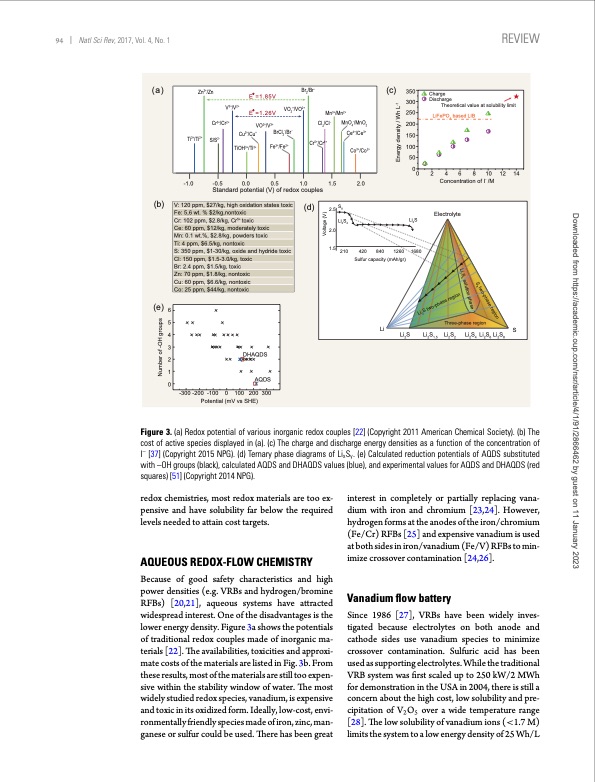
PDF Publication Title:
Text from PDF Page: 004
94 Natl Sci Rev, 2017, Vol. 4, No. 1 REVIEW (a) (b) (e) 6 5 4 3 2 1 0 (c) 350 300 250 200 150 100 50 0 0 2 4 6 8 10 12 14 Concentration of I- /M Zn2+/Zn Ti3+/Ti2+ E =1.85V Br2/Br - V3+/V2+ Cr3+/Cr2+ S/S2- E =1.26V VO2+/VO2+ VO2+/V3+ Cu2+/Cu+ BrCl2-/Br - TiOH3+/Ti3+ Fe3+/Fe2+ Cr5+/Cr4+ -1.0 -0.5 0.0 0.5 1.0 1.5 2.0 Standard potential (V) of redox couples (d) V: 120 ppm, $27/kg, high oxidation states toxic Fe: 5,6 wt. % $2/kg,nontoxic Cr: 102 ppm, $2.8/kg, Cr5+ toxic Ce: 60 ppm, $12/kg, moderately toxic Mn: 0.1 wt.%, $2.8/kg, powders toxic Ti: 4 ppm, $6.5/kg, nontoxic S: 350 ppm, $1-30/kg, oxide and hydride toxic Cl: 150 ppm, $1.5-3.0/kg, toxic Br: 2.4 ppm, $1.5/kg, toxic Zn: 70 ppm, $1.8/kg, nontoxic Cu: 60 ppm, $6.6/kg, nontoxic Co: 25 ppm, $44/kg, nontoxic -300 -200 -100 0 100 200 300 Potential (mV vs SHE) DHAQDS AQDS Mn3+/Mn2+ Cl2/Cl - MnO4-/MnO2 Ce4+/Ce3+ Co3+/Co2+ Charge Discharge Theoretical value at solubility limit LiFePO based LIB 4 S 2.5 8 Li S 24 2.0 1.5 Li2S Electrolyte Three-phase region 210 420 840 Sulfur capacity (mAh/gr) Li 1260 1680 S 2 21.522242628 LiS LiS LiS LiS LiS LiS Figure 3. (a) Redox potential of various inorganic redox couples [22] (Copyright 2011 American Chemical Society). (b) The cost of active species displayed in (a). (c) The charge and discharge energy densities as a function of the concentration of I– [37] (Copyright 2015 NPG). (d) Ternary phase diagrams of LixSy. (e) Calculated reduction potentials of AQDS substituted with –OH groups (black), calculated AQDS and DHAQDS values (blue), and experimental values for AQDS and DHAQDS (red squares) [51] (Copyright 2014 NPG). redox chemistries, most redox materials are too ex- pensive and have solubility far below the required levels needed to attain cost targets. AQUEOUS REDOX-FLOW CHEMISTRY Because of good safety characteristics and high power densities (e.g. VRBs and hydrogen/bromine RFBs) [20,21], aqueous systems have attracted widespread interest. One of the disadvantages is the lower energy density. Figure 3a shows the potentials of traditional redox couples made of inorganic ma- terials [22]. The availabilities, toxicities and approxi- mate costs of the materials are listed in Fig. 3b. From these results, most of the materials are still too expen- sive within the stability window of water. The most widely studied redox species, vanadium, is expensive and toxic in its oxidized form. Ideally, low-cost, envi- ronmentally friendly species made of iron, zinc, man- ganese or sulfur could be used. There has been great interest in completely or partially replacing vana- dium with iron and chromium [23,24]. However, hydrogen forms at the anodes of the iron/chromium (Fe/Cr) RFBs [25] and expensive vanadium is used at both sides in iron/vanadium (Fe/V) RFBs to min- imize crossover contamination [24,26]. Vanadium flow battery Since 1986 [27], VRBs have been widely inves- tigated because electrolytes on both anode and cathode sides use vanadium species to minimize crossover contamination. Sulfuric acid has been used as supporting electrolytes. While the traditional VRB system was first scaled up to 250 kW/2 MWh for demonstration in the USA in 2004, there is still a concern about the high cost, low solubility and pre- cipitation of V2O5 over a wide temperature range [28]. The low solubility of vanadium ions (<1.7 M) limits the system to a low energy density of 25 Wh/L Number of -OH groups Voltage (V) Energy density / Wh L-1 Li S solution phase 24 S two-phase region 8 Li S two-phase region 2 Downloaded from https://academic.oup.com/nsr/article/4/1/91/2866462 by guest on 11 January 2023PDF Image | Progress in low cost redox flow batteries energy storage

PDF Search Title:
Progress in low cost redox flow batteries energy storageOriginal File Name Searched:
nww098.pdfDIY PDF Search: Google It | Yahoo | Bing
Salgenx Redox Flow Battery Technology: Salt water flow battery technology with low cost and great energy density that can be used for power storage and thermal storage. Let us de-risk your production using our license. Our aqueous flow battery is less cost than Tesla Megapack and available faster. Redox flow battery. No membrane needed like with Vanadium, or Bromine. Salgenx flow battery
| CONTACT TEL: 608-238-6001 Email: greg@salgenx.com | RSS | AMP |